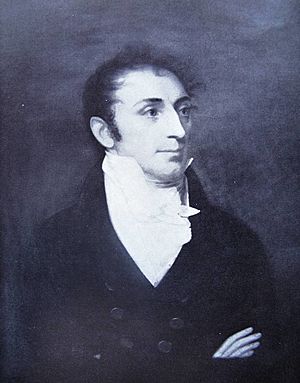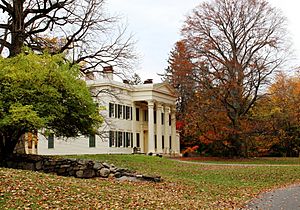Peter Augustus Jay (lawyer) facts for kids
Quick facts for kids
Peter Augustus Jay
|
|
|---|---|
 |
|
| Recorder of New York City | |
| In office April 6, 1819 – March 6, 1821 |
|
| Preceded by | Richard Riker |
| Succeeded by | Richard Riker |
| Member of the New York State Assembly from New York Co. | |
| In office July 1, 1815 – June 30, 1816 |
|
| Personal details | |
| Born |
Peter Augustus Jay
January 24, 1776 Elizabethtown, New Jersey, U.S. |
| Died | February 20, 1844 (aged 68) New York City, U.S. |
| Political party | Federalist |
| Spouses |
Mary Rutherfurd Clarkson
(m. 1807; |
| Children |
|
| Parents | John Jay Sarah Van Brugh Livingston |
| Relatives | William Jay (brother) William Livingston (grandfather) Augustus Jay (grandson) |
| Alma mater | Columbia College |
Peter Augustus Jay (born January 24, 1776 – died February 20, 1843) was an important lawyer and politician in New York. He was the oldest son of John Jay, who was a Founding Father of the United States and the very first Chief Justice of the Supreme Court.
Contents
Peter Augustus Jay's Early Life
Peter Augustus Jay was born on January 24, 1776. This happened at "Liberty Hall" in Elizabethtown, New Jersey. It was the home of his mother's parents.
Peter was one of six children. His parents were John Jay and Sarah Van Brugh Livingston Jay. He had one younger brother, William, and four sisters.
His father's parents were Peter Jay and Mary Van Cortlandt. Peter Jay was a rich trader in New York City. Mary's father, Jacobus Van Cortlandt, was the mayor of New York City twice.
His mother was the oldest of 13 children. Her father was William Livingston, who was the Governor of New Jersey.
Peter followed his father's path. His father went to King's College (now Columbia University). Peter also graduated from Columbia University in 1794.
Peter Augustus Jay's Career in Law and Politics
After graduating in 1794, Peter worked for his father in London. He was his father's private secretary during talks for the Jay Treaty.
Young Peter then studied law. He started his own law practice in New York City. He worked with his cousin, Peter Jay Munro. This continued a family tradition of public service.
Political Roles and Public Service
Peter was a member of the Federalist Party. He served in the New York State Assembly from New York City. This was during the 39th New York State Legislature.
During this time, he helped get money for the Erie Canal. This was a big project to build a waterway. He tried many times to be elected to Congress. However, he was always defeated by candidates from the Democratic-Republican Party.
From 1819 to 1821, he was the Recorder of New York City. This was a legal position. In 1821, he was a delegate from Westchester County. He helped write the new New York State Constitution. He also served as a judge in Westchester County for a while.
Helping Others: Philanthropy and Groups
In 1814, Peter and his father became members of the American Antiquarian Society. This group studies American history and culture.
Peter also helped start New York's first savings bank in 1816. It was called the New York Bank for Savings. This helped create the savings bank system in New York State.
In 1828, he helped create the New York Law Institute. This is the oldest law library in New York City today. Peter was also the President of New York Hospital from 1827 to 1833. He was Chairman of the Board of Trustees for King's College. He also served as President of the New-York Historical Society from 1840 to 1842.
In 1832, Harvard University gave him an honorary Doctor of Laws degree. Columbia University also gave him one in 1835. They recognized his "talents and virtues."
Fighting for Social Justice
Peter Augustus Jay believed in fairness for everyone, just like his father. He worked hard to gain more rights for African Americans.
He was President of the New York Manumission Society in 1816. This group worked to end slavery. He also led the New York Public School Society. This group was against slavery and wanted to help poor people.
Peter is best known for a speech he gave in 1821. He was a delegate at the New York State Constitutional Convention. He argued that free African Americans should have the right to vote. He said that the idea of black people being less capable was "completely refuted and universally exploded." Even with his strong speech, his idea to let more people vote was not approved.
Peter Augustus Jay's Family Life
On July 29, 1807, Peter married Mary Rutherfurd Clarkson (1786–1838). Mary was the daughter of General Matthew Clarkson. Her uncle was U.S. Senator John Rutherfurd.
Peter and Mary had eight children together:
- John Clarkson Jay (1808–1891), who became a doctor and a famous expert on seashells.
- Mary Rutherfurd Jay (1810–1835).
- Sarah Jay (1811–1846).
- Catherine Helena Jay (1815–1889).
- Anna Maria Jay (1819–1902).
- Peter Augustus Jay (1821–1855).
- Elizabeth Clarkson Jay (1823–1895).
- Susan Matilda Jay (1827–1910).
His wife, Mary, passed away on December 24, 1838, in Madeira. Peter Augustus Jay died in New York City on February 20, 1843.
His children and grandchildren became teachers, lawyers, diplomats, and community leaders. Some of his descendants include Mary Rutherfurd Jay, Pierre Jay, and Jay Pierrepont Moffat.
The Jay Estate
Peter Augustus officially received the Jay Estate in Rye from his father in 1822. However, he and his wife Mary were already managing the home's costs as early as 1814.
With his father's help, Peter Augustus added stone walls called "ha-has" to the property. He also planted elm trees. His father, John Jay, died in 1829.
In 1836, Peter Augustus hired a builder, Edwin Bishop. They took down the old farmhouse, which had been damaged during the Revolutionary War. Peter Augustus used parts from "The Locusts," where his father grew up. He helped create the Greek Revival mansion that stands there today. Sadly, his wife Mary did not live to see the house finished.
After Peter's death in 1843, the Rye house went to his oldest son, John Clarkson Jay.
The Jay Estate is a National Historic Landmark. This means it is very important to U.S. history. It is also part of the Boston Post Road Historic District (Rye, New York). The non-profit organization, the Jay Heritage Center, is working to preserve and restore the Jay mansion. They use it as an educational center for American history programs.
In 2008, the Jay mansion became the first National Historic Landmark in Westchester County to get a special heating and cooling system. This system uses the earth's temperature (geothermal).
Peter Augustus Jay and John Jay were leaders in the movement to end slavery. The Jay Heritage Center has a program called "Striving for Freedom" that explores this. Because of their work for social justice, the Jay site was added to the Westchester County African American Heritage Trail in 2004.
See also
- United States House of Representatives elections in New York, 1806
- United States House of Representatives elections in New York, 1810
- United States House of Representatives elections in New York, 1812


